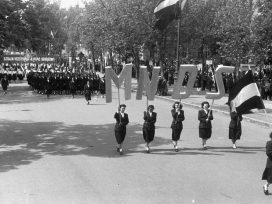I nearly missed the publication of a great work. Many interesting and better-looking books were published in those days, and I only knew about Sorstalanság ( Fatelessness ), by Imre Kertész, because my friend Péter Hajnóczy – an excellent writer who died young – mentioned it to me in the summer of 1975. Once I’d read it, I recommended it to all my friends. They loved it too, and we were anxious to read the reviews. The reviews, all three of them, praised the book, but there was nothing in there to indicate that a classic work of world literature had been created.
After World War II, the communist government implemented a Soviet-style literary regime in Hungary. The works of writers who supported the system were published in huge numbers. The works of writers who could not participate in this propaganda were not published at all. After the death of Stalin, the hard-line dictatorship in Hungary faltered too. Some of the Communists who had been enthusiastic until then began to criticize the system. Writers played a significant role in the outbreak of the 1956 revolution, and, after the revolution was suppressed, some of the reform communist writers were imprisoned. Others were forced into silence.
There was a desperate search for young writers still loyal to the communist system, but there was no way to fully restore the situation as it had existed during Stalin’s lifetime. The Kádár system began a process of stabilization, part of the consolidation that all long-term dictatorships go through. An increasing number of independent writers were allowed to publish; a situation similar to that of the poputchik writers in the Soviet Union during the 1960s.
Suddenly, there was not only the artificially inflated fame of writers who propagated the official ideology. Fame was also coming to writers not willing to work in accordance with party directives. During the 1960s, a tremendous thing happened: books by banned Hungarian writers and works of world literature that had been banned for fifteen years were allowed on the shelves. The works of Thomas Mann, Kafka, Camus, Sartre, and Solzhenitsyn were a revelation for Kertész. Others also read and debated existentialism, the last philosophy of the twentieth century that can be taken seriously.
Within the atmosphere of this colourful and vibrant intellectual life, Imre Kertész decided to write novels. He hoped – and he had reason to – that his works would be widely appreciated. In those days, even an unknown writer could expect that five to ten thousand copies of his or her first book would be published. As far as I know, nobody was as radically committed to being a writer as Kertész was. He didn’t have a proper job, and only made money with a few things here and there. He and his unselfish wife lived off almost nothing more than her wage, just so he could go on writing. Hard as this was, the age he lived in provided favourable circumstances for such a stunning undertaking. Although everyone was poor, nobody died of starvation and there was a roof over everyone’s head: the cramped apartment Kertész lived in is described point for point in his book Kudarc [published in German translation as Fiasko ]. Since no one was allowed to go into business and make money, there was plenty of time for educational activities such as reading and learning. At that time, people still read, in the last, archaic moment before the stunning explosion of visual culture.
Censorship was not as strict as it had been in the 1950s and immediately after the revolution of 1956. Certain subjects were taboo, such as the presence in the country of Soviet occupying troops. The 1956 revolution could only be called a “counter-revolution”, and criticizing communist ideology was not permitted. However, writers learned how to send their message, and cooperative readers learned to read between the lines.
The Janus-face of the censor
Russian writers often joke that it was censorship that made nineteenth-century Russian literature so great. Political subjects were not allowed, so writers turned to the deep corners of the soul. Also, the majority of the Czar’s censors were in truth educated men, well-read people who loved literature and helped writers whenever they could. Remnants of this tradition existed during Soviet times, too. If, for example, we compare the first, censored Soviet edition of Bulgakov’s The Master and Margarita with the full text of the Russian-language edition published in Switzerland, we can see that the Soviet censor deleted only unimportant parts. The novel was barely damaged, but the censor had still done his job and the book could be published.
This is how most Hungarian censors handled books. They were called, most discreetly, editors. But they didn’t always work against writers. They were more worried about other censors, ones who might or would report them for not being sufficiently diligent. And, of course, there was more than one layer of censorship. Books sent to the state censors had already been censored by the publishing house: both the Hungarian literary publishers had a “super censor” in place, reliable academics that were loyal to the party but also had an eye for quality. Once these men had accepted a manuscript, it was forwarded to the appropriate ministerial department. There it was authorized, or, in debatable cases, forwarded to the appropriate department of the party. Manuscripts approved in this way were still not sure; the completed, bound book had to go through this same path of censorship again. The reasoning was that anything could happen during the one and a half to two years that it took, in a good case, to create a book from a manuscript. A work that was previously considered harmless could have turned into a powder keg, just waiting to explode into a fire of international imperialism. If that happened, the book could not be published immediately, and had to wait for a cooler climate. It took as much as a decade for several great books to be published.
However, in socialist Hungary, all good books were published eventually, and when the system changed, there was no significant work that had been banned and never published. (The only exception is the work of the poet György Petri. Although those in charge often tried to lure him into the ranks of published writers, Petri refused to compromise and only published in samizdat publications.) The situation was better in Hungary than in other eastern European countries, which is why the Czechs and the Poles envied the Hungarians in the 1960s and 1970s. There were several samizdat publications that cropped up at that time, publishing philosophy, political science, and sociology. There was no literature (with the exception of Petri’s poems).
The first publishing house that Imre Kertész brought his masterpiece to rejected him, an experience Kertész depicts in Kudarc . He also submitted it to another publishing house whose head was neither a former internal affairs officer nor a professed Jewish Communist, but a second-level “bourgeois” writer who got along well with communism. He published the novel. Up to this point, it is a regular story of its time.
An unpopular individualist
It was also normal that three favourable reviews were published about the novel. Of course, they didn’t favour it too much: the 46-year-old writer with his first novel did not belong to any circle. His generation already had its acknowledged writers, and nobody could break into their circle. Inter-generational conflict is always part of literary life. The eastern European mentality can accept individualists only if they can be considered to be an obedient part of the collective. The hierarchical relationships of Hungarian literary life remained feudal. This communal mentality, whose peasant origins were aggravated by petit-bourgeois romanticism, was further enhanced by the forced mythos of the communist ideology. Newcomers were evaluated by several officially sanctioned national prophets; if a newcomer came forward with an original voice or a strong individual personality, though not as the sword-bearer of a literary notability, then they were forced to keep quiet. Although their works were published, they were not advertised. Reviews of that time were based on politics and ideology, rather than aesthetics. The attitude of Kertész fitted neither the official Hungarian ideology of the time, nor the more or less oppositional ideology, since the opposition inevitably mapped the structure of the existing power onto their small circle, albeit with a different ideology.
Therefore, nobody indicated that the Fatelessness was a masterpiece, since nobody could see it. It was only Péter Hajnóczy, an educated, sensitive, vagrant alcoholic who lived on the peripheries, who noticed it. He accurately recognized that it was the work of a deviant author. This is what those intellectuals felt who, although having read the novel, dismissed it. The ruthlessly ironic and disrespectfully tragic attitude of Fatelessness did not fit into Hungarian intellectual etiquette.
As Kertész has said in an interview, Fatelessness is not only about Nazism. The experience gained during Hungarian socialism was also necessary for its creation. The novel is about the Hungarian Jews, the most assimilated Jews in Europe, who gave up their religion, language, and tradition in the nineteenth century even more than the German Jews did. That is why the Hungarian Jews were so shocked when their segregation began after World War I. In the 1930s, increasingly serious laws militated against them, but they complied without rebellion. Jews were forced to wear the yellow star; then they were rounded up and transported in their hundreds of thousands to death camps. The Polish or Rumanian Jews were less surprised by the turn of events: since they were less assimilated, they were capable of more resistance.
The tradition of repression
The Hungarian participation in the elimination of more than half a million Hungarian Jews, based on modest estimates, was not faced in Hungary while Kertész was writing Fatelessness , nor has it been faced since. After the system changed, the political anti-Semitism that was originally generated within internal power struggles in the 1980s became stronger. Racial theories are as vivid now as they were in the 1930s. The difference is that while anti-Semitism is now only popular among intellectuals, anti-Gypsy racism, and xenophobia in general, has nationwide currency.
The attitude of Fatelessness was and still is unpleasant. Only the brilliant Polish writer, Tadeusz Borowski, created a similar masterpiece in his two novels about Auschwitz and its consequences. Borowski, who was an Auschwitz survivor and committed suicide in the 1950s at the age of 29, is not popular in Poland or elsewhere. Like Borowski, Kertész systematically demythicized the Holocaust, describing it as a natural consequence of the modern world. (Borowski extended the Holocaust – though he did not use this highly inaccurate and unfortunately widely-used word –to the entire system of slavery.) In the view of Kertész, just like that of Borowski, there is no difference between the death camp and the peaceful hinterland . Neither author is moved when they look at the victims: they depict the majority of them as participants and more or less active collaborators. In their eyes, the killers are normal people who participate in well-organized acts that society supports fully. Crime is anthropologically bound to mankind, which is not to say that it should not still be considered crime, even if – and this is the basis of the paradoxical optimism of their works – there is no stable point from which to view it.
Kertész’s approach has never been compatible with the Hungarian mentality, nor, for that matter, with that of other nations. His attitude is unpleasant. Embarrassing. Not Jewish. Not Hungarian. Not anti-German enough. Telling the truth with murderous irony? Who benefits from such a thing? It is politically unusable. After all the temptations of the twentieth century, and the lack of any prospects for the future, people’s souls are thirsting for kitsch. So a radical novel such as Fatelessness complies neither linguistically nor conceptually with the usual tear-jerking Jewish salvation-history, whose climax, whose “extrahistorical event” (Ágnes Heller), was Auschwitz.
From 1961 to 1973, while Kertész was writing his book, it seemed that Hungarian society was willing to embrace intellectual originality; it was a propitious moment to look oneself in the eye and contemplate the tragic. It is our great luck that Kertész believed in it, and that it turned out only later that all of the anti-human ideologies of the nineteenth and twentieth centuries still hide, unprocessed, inside the soul. Since then, a wildly romantic nationalism has flourished where weapons have been put down. In such an intellectual environment, the unbelievable soberness and perfect normality of Kertész’s novel was and still is a violation of norms.






